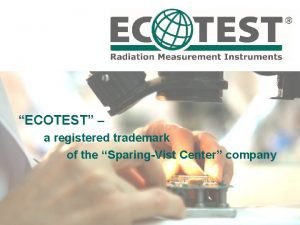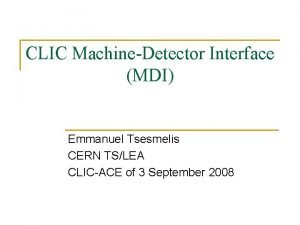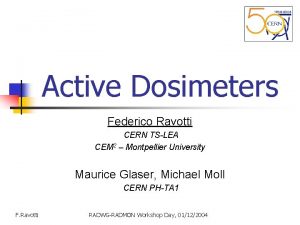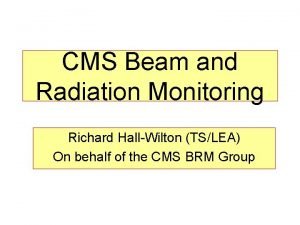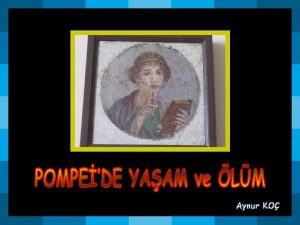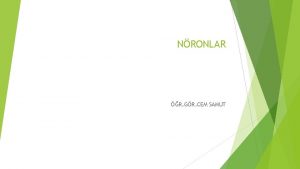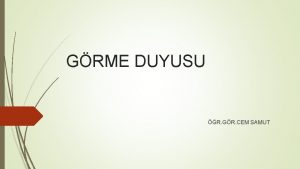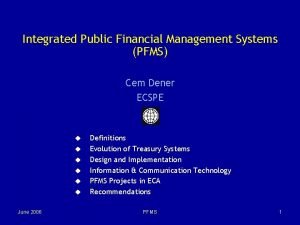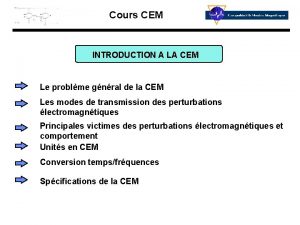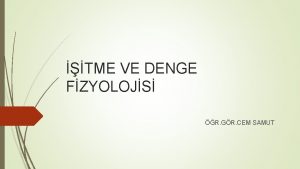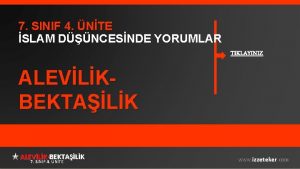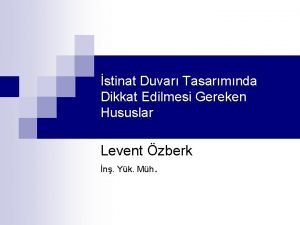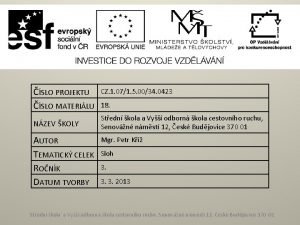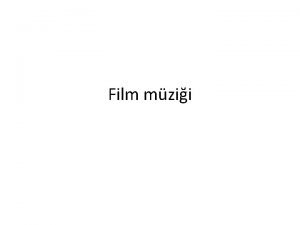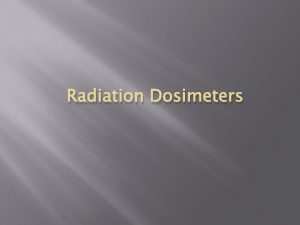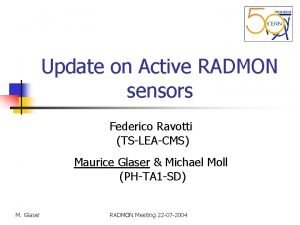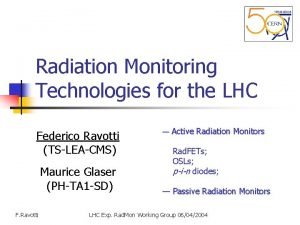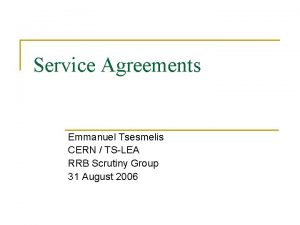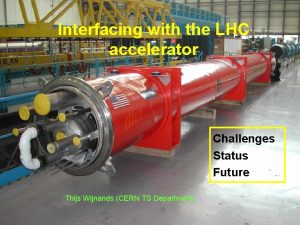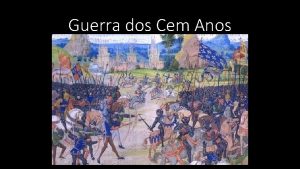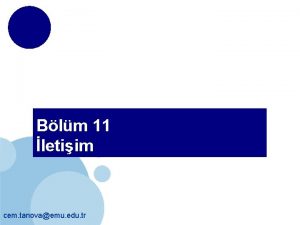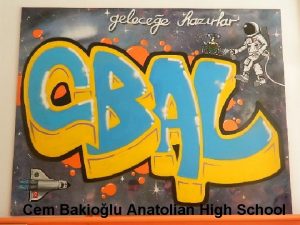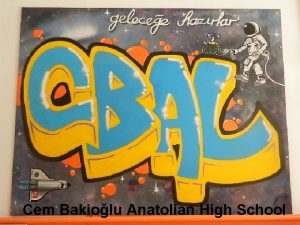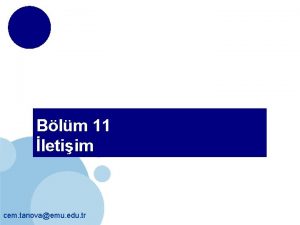Active Dosimeters Federico Ravotti CERN TSLEA CEM 2


















- Slides: 18

Active Dosimeters Federico Ravotti CERN TS-LEA CEM 2 – Montpellier University Maurice Glaser, Michael Moll CERN PH-TA 1 F. Ravotti RADWG-RADMON Workshop Day, 01/12/2004

Outline Ø Introduction; Ø Total Ionizing Dose (TID) measurement: Ø • Radiation Field Effect Transistors (Rad. FETs); • Optically Stimulated Luminescent materials (OSLs); 1 -Me. V neutron equivalent fluence (Feq) measurement: • p-i-n diodes & PAD structures; Ø Thermal neutrons detection (Fth); Ø Status Dec. 2004 & Conclusion. F. Ravotti RADWG-RADMON Workshop Day, 01/12/2004 2

Introduction 1) RADIATION DAMAGES can be caused by: Ø Ionizing Energy Losses (IEL) Total Ionizing Dose (TID); Ø Non-Ionizing Energy Losses (NIEL) 1 -Me. V neutron eq. fluence (Feq). 2) Important to monitor separately TID, Feq and maybe Fth; 3) The best “dosimeter” for electronics is Silicon itself (or similar Zeff); 4) Accelerator environments are (t) Active (“on-line”) monitoring; 5) Monitoring is NOT ONLY for radiation damage survey. F. Ravotti RADWG-RADMON Workshop Day, 01/12/2004 3

Active Radiation Monitors TID (Gy. Si) mainly charged particles and photons Feq mainly fast hadrons Forward biased p-i-n diodes Rad. FETs Optically Stimulated Luminescence (OSL) F. Ravotti -2 (cm ) Reverse biased PAD structures RADWG-RADMON Workshop Day, 01/12/2004 4

Rad. FETs General (1) e-/h+ pair generation; (2) e-/h+ pair recombination; (3) e- (~psec) / h+ (~sec) transport; (4) hole trapping; (5) Interface state delayed buildup. VGS Si. O 2 i. D Fixed i. D VGS growths TID Si F. Ravotti RADWG-RADMON Workshop Day, 01/12/2004 5

Rad. FETs Details J Dosimetric information kept stored; J 2 wires, long-distance readout; J Sensitivity vs. Dynamic range is (dox); L “Saturation problems” can arise at high Feq if oxide is not well chosen! ® CERN-PH-EP-2004/045 L Limited lifetime sensitivity loss (saturation); J Dynamic range up to 100 k. Gy. Si; L Particle-dependent response: ® proper calibration! J Several ways to reduce T influence; L “Drift-up” when switched on: ® proper readout scheme! J “Neutron insensitive” devices. L Annealing and Interface States F. Ravotti generation in oxides: ® selection on Si. O 2 “quality”; RADWG-RADMON Workshop Day, 01/12/2004 6

Rad. FETs Selection Procedure Response to single radiation Response to and Room Temp. Annealing some particle Accelerated procedure based on the scaling annealing t fields and at high Si. O 2 “quality” evaluation (Isochronal Annealing) Response at Low Dose-Rate doses were missing in literature! in Mixed Environment annealing T Devices packaging options TWO types recommended for CERN purposes ! F. Ravotti RADWG-RADMON Workshop Day, 01/12/2004 Aim of the 2004 irradiation campaigns 7

OSLs General (collaboration with CEM 2 – Montpellier University) (1) e-/h+ pair generation and trapping; (2) Infrared stimulation (800 -1500 nm); (3) Visible emission (500 -700 nm). , Sm e C : Sr. S Courtesy of L. Dusseau, CEM 2 IR stimulation Peak Amplitude increases OSL Photosensor F. Ravotti linearly with TID The readout completely reset sec the sensitive material! RADWG-RADMON Workshop Day, 01/12/2004 8

OSLs Details J Sensitivity from 10 m. Gy to 102 Gy; J Infinite lifetime (readout = reset); J Zeff (~ 30) close to electronics; J Response NOT particle-dependent; J Different ways to built an OSL-based active dosimeter. L Complicate fading behaviour; L The related sensor equipment for active dosimetry must be radhard: Main problem in the development of this J Intrinsically neutron insensitive: ® We make them sensitive! F. Ravotti L Long-distance readout with 5 wires; technology at CERN! RADWG-RADMON Workshop Day, 01/12/2004 9

Neutron-sensitive OSLs FACILITIES NEUTRON SPECTRA IRRAD 2 Facility TRIGA Reactor OSL+B OSL+PE First measurements match very well the facility spectra F. Ravotti RADWG-RADMON Workshop Day, 01/12/2004 10

3 1. cm 5 cm x OSL “on-line” approaches Integrated Space sensor based on COTS (Version 2) ® “sandwich” LED / OSL / photo-sensor; ® LED current electronically controlled; ® Optimized for long-distance readout; ® Hardness in n field under investigation: (tested for e, p up to Feq=1011 cm-2). Courtesy of J. R. Vaillé, CEM 2 OSLs deposed on “radhard” photo-sensor & LED Fibred system F. Ravotti ® Gain in sensitivity, reproducibility; ® Gain in radiation hardness. ® First prototype: 2. 3 m. V/c. Gy ® 2 fibers inside 20 m x 4 mm 2 pipe with OSL at one end; ® Stimulation = Laser 1060 nm; Light detection = PM. ® Less radhard constraints (PM/Laser not exposed!) RADWG-RADMON Workshop Day, 01/12/2004 11

p-i-n & PAD General Displacement damage in high r Si-base Macroscopic effects both linear with Feq FORWARD BIAS Fixed i. F voltage increase VF REVERSE BIAS Chosen VR leakage current increase i. L i. F Ø Ø Readout with fast pulse; Sensitivity depends on: ® ® F. Ravotti Injection level; Base width (W). VR Ø Ø Readout under full depletion V; Sensitivity depends on sensor volume. RADWG-RADMON Workshop Day, 01/12/2004 12

p-i-n & PAD Details FORWARD Operation - vs. - REVERSE Operation J Current pulse; L High voltage maybe needed. J 2 wires, long-distance readout; K 2 wires, more complicate read-out; L Feq range dependent on diode W; J Very wide Feq range; J Typically ~ 1. 5 m. V / 108÷ 1010 cm-2; J Typically ~ 2 n. A / 1010 cm-2; L Strong T dependence; K Relative low room T annealing; L Complex annealing behaviour; J Possible to use COTS! J Very reliable devices. F. Ravotti RADWG-RADMON Workshop Day, 01/12/2004 13

Commercial p-i-n diodes Commercial (thin base) BPW 34 F Feq = 2 x 1012 4 x 1014 cm-2 3 – USE CUSTOM-MADE DEVICES Low Flux irradiation in PS-T 7 2004 (Max Feq = 2 x 1012) 2 – STUDY BPW 34 F RESPONSE AT DIFFERENT INJECTION LEVELS! 1 – PERFORM PRE-IRRADIATION ON BPW 34 F Low Flux irradiation in PS-T 7 2004 F. Ravotti RADWG-RADMON Workshop Day, 01/12/2004 14

Thermal n detection 1) OSL doped with 10 B: + n 7 Li + a + g (s 2200 = 3840 b); § 10 B § Dose deposition in OSL by low range reaction fragments. § More: Ravotti, Glaser, et al. , RADECS 2004, CERN-PH-EP-2004/022 2) Damage in npn bipolar transistors: § Boron is usual dopant in p-type Si; § Fragment produce bulk damage in transistor base; § Increase of ib for fixed ic Dib = kth· Fth+ keq· Feq § More: Mandic, Kramberger, et al. , ATLAS-IC-ES-0017 (EDMS 498365). 3) 100 -mm layer Fission converter on Silicon: § 235 U § Very high LET fragments efficient discrimination in mixed field. § More: Rosenfeld, Kaplan, et al. , Med. Phys. 26(9), pp. 1989, 1999 F. Ravotti + n 140 X + 95 Y + 2 n (s 2200 = 580 b); RADWG-RADMON Workshop Day, 01/12/2004 15

Status Dec. 2004 Ø Rad. FETs: 9 devices from 4 producers tested: We recommend two types of Rad. FETs for low (100 m Gy ÷ 10 Gy) and high (1 c. Gy ÷ 10 k. Gy) dose ranges; Ø OSLs: Need some more development for use as radhard active dosimeter; Ø p-i-n diodes: ® COTS devices: ready to be used, some optimization needed; ® Custom-made devices: ready to be used; Ø PAD structure: ® Dedicated batch of devices to be produced; Ø Thermal neutron detectors: ® OSL and diodes with fission converter: working principle shown; ® npn bipolar transistors ready to be used (ATLAS). F. Ravotti RADWG-RADMON Workshop Day, 01/12/2004 16

Conclusion ® Several techniques for the ACTIVE monitoring of the TID, Feq and Fth have been presented; ® All presented devices are reliable and were characterized in various radiation fields; ® Most of them are commonly used in Medicine and Space: customization and calibration for CERN applications needed; ® ACTIVE monitors are also PASSIVE dosimeters (don’t forget it !!) More on: http: //cern. ch/lhc-expt-radmon & http: //www. cern. ch/irradiation F. Ravotti RADWG-RADMON Workshop Day, 01/12/2004 17

Acknowledgments Pr. L. Dusseau, J. R. Vaillé and all the team of the “Electronic and Radiation research Laboratory” at the CEM 2, Montpellier University, France; I. Mandić, G. Kramberger, M. Mikuž from JSI, Ljubljana, Slovenia; A. G. Holmes-Siedle (REM, UK), G. Sarrabayrouse (CNRS-LAAS, France), A. Rosenfeld (CMRP, Australia); C. Joram, E. Tsesmelis and all the personnel of the PH-Bonding Lab (CERN); All the operators of the CERN-PS accelerator for their assistance during the experiments. F. Ravotti RADWG-RADMON Workshop Day, 01/12/2004 18
